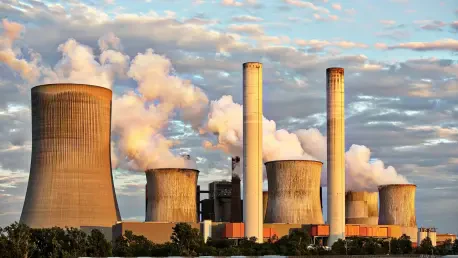The European chemical industry, often hailed as the backbone of the continent’s industrial might, stands on the brink of a profound crisis that threatens not just its own future but the broader economic stability of the region. Employing over one million people and underpinning vital sectors such as healthcare, defense, and energy, this industry has been described by European Commission President Ursula von der Leyen as the “industry of industries.” Yet, mounting financial losses, fierce global competition, and uncompetitive energy costs have pushed companies to a critical juncture where tough decisions about survival are no longer optional but essential. The urgency of the situation cannot be overstated, as delays in addressing these challenges could lead to irreversible damage. This raises a pressing question: can swift and decisive action turn the tide for an industry that has long been a cornerstone of Europe’s economic prowess, or is the window of opportunity already closing?
Mounting Pressures and Declining Competitiveness
The challenges facing the European chemical sector are multifaceted, stemming from both internal vulnerabilities and external economic forces that have intensified over recent years. A significant decline in demand, coupled with energy prices that remain uncompetitive compared to global counterparts, has eroded the industry’s standing. Additionally, competition from regions like China has grown fiercer, while geopolitical shifts, including protectionist policies and tariffs imposed by the United States, have disrupted the free trade model that once fueled success. These tariffs, influenced by trade policies under President Trump, have added strain to an already struggling sector, forcing companies to reevaluate their operational strategies. The combination of these pressures has created a perfect storm, leaving the industry grappling with how to regain its footing in a rapidly changing global landscape where adaptability is no longer a choice but a necessity for survival.
Beyond market and geopolitical challenges, the data paints an even grimmer picture of the sector’s health, highlighting the depth of the crisis that demands immediate attention. According to the European industry body CEFIC, competitiveness remains well below pre-crisis levels, with output expected to decline further in the coming years. This downturn is not an isolated incident but mirrors a broader economic slump affecting nearly every major sector across the European Union. Production growth figures for the first half of the current period show negative trends, signaling a systemic issue that extends beyond chemicals alone. The implications are stark: without intervention, the ripple effects could undermine not just industrial output but also the millions of jobs and ancillary industries that depend on a robust chemical sector. The urgency for strategic measures to counteract these trends has never been more apparent, as each passing day without action deepens the industry’s predicament.
Corporate Retreat and Financial Fallout
The response from major players in the European chemical market underscores the severity of the situation, as multinational corporations are increasingly pulling back from the region at significant financial cost. Companies like ExxonMobil have begun offloading plants under pressure from tariffs, while LyondellBasell is in talks to sell facilities across France, Germany, the UK, and Spain, anticipating losses between $700 and $800 million. Similarly, Dow Chemical has announced plans to shutter three major assets, expecting charges ranging from $630 to $790 million. Saudi-owned SABIC is closing its UK Wilton cracker and exploring the sale of its entire European petrochemicals business, while Thai-owned PTT Chemicals abruptly shut down its Vercorex plant in France, affecting downstream operations. These divestitures and closures reflect a broader trend of retreat, signaling a lack of confidence in the region’s ability to provide a viable operating environment amid escalating challenges.
This wave of corporate exits is not merely a series of isolated decisions but a systemic reaction to an unsustainable economic climate that threatens the industry’s long-term presence in Europe. The financial losses incurred by these companies are staggering, yet they pale in comparison to the potential consequences of inaction for the broader economy. Over 20 major production sites have already been shuttered, each closure representing not just a loss of output but also a blow to local communities and supply chains that rely on these facilities. The ripple effects extend to smaller firms and related industries, amplifying the economic impact. As foreign investment wanes, the question remains whether European stakeholders can create conditions to stem this tide of divestment. The decisions made by these corporations today are a stark reminder that the clock is ticking, and the cost of delay could be catastrophic for an industry already on the ropes.
Pathways to Recovery and Urgent Action Needed
Despite the bleak outlook, there is a glimmer of hope in the form of strategic proposals aimed at revitalizing the European chemical industry while balancing sustainability and security goals. CEFIC has dedicated significant effort over the past two years to craft priority measures designed to enhance competitiveness. These initiatives have gained traction with the European Commission and national governments, leading to the development of a comprehensive Action Plan. The focus is on addressing core issues like energy costs and regulatory burdens while ensuring the sector remains aligned with broader environmental commitments. However, the critical challenge lies in translating these plans into tangible outcomes swiftly enough to make a difference. The consensus among stakeholders is clear: while solutions exist, their effectiveness hinges on the speed of implementation in a landscape where every moment counts.
Reflecting on the path forward, it is evident that the slow pace of governmental response stood in stark contrast to the rapid deterioration witnessed across the sector. The urgency that industry leaders felt was often met with prolonged discussions rather than immediate action, a delay that cost valuable time. Looking back, the closures of key facilities and the financial hemorrhaging of major firms served as stark reminders of what was at stake. The actionable next steps must prioritize rapid policy execution, fostering an environment where energy costs are competitive and regulatory frameworks support innovation. Additionally, stronger collaboration between public and private entities could have bolstered resilience against global competition. As history reflects on this critical period, the hope remains that lessons learned will drive future considerations, ensuring that such a vital industry never again teeters so close to the edge of collapse without a robust and timely response.









